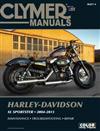
Softcover – 616 pages – Harley-Davidson Sportster XL883 XL1200 2004 – 2013 Clymer Owners Service Repair Manual covers the following models: Sportster XL833 (2004-2009) XL883C Custom (2004-2010) XL883L Super Low (2004-2013) XL883N Iron (2009-2013) XL883R Roadster (2004-2013) XL1200C Custom (2004-2013) XL1200L Super Low (2004-2011) XL1200N Nightster (2007-2012) XL1200R Roadster (2004-2009) XL1200V 72 (2010-2013) Sportster XL1200X 48 (2010-2013)Note: this manual DOES NOT include XR1200Contents: AMENDMENTOn the 2/1 edition page X (QRD) and page 538 have been changed to note the engine oil capacity on: 2008 – 2009 models is 2.8 qt (2.65 litre) 2004 – 2007 models the capacity is 3.6 qt. (3.4 litre) QUICK REFERENCE DATA GENERAL INFORMATIONManual organization / Warnings cautions and notes / Safety / Serial numbers / Fasteners / Shop supplies / Tools / Measuring tools / Ele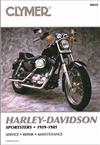
Softcover – 376 pages – Harley-Davidson Sportsters 1959 – 1985 Clymer Owners Service Repair Manual Covers the following Models: Harley-Davidson H Sportster (1959-1969) Harley-Davidson CH Sportster (1959-1969) Harley-Davidson XLCH Sportster (1970-1980) Harley-Davidson XLH Sportster (1970-1972 1978-1985) Harley-Davidson XLCR Sportster (1977-1978) Harley-Davidson XLX Sportster (1983-1985) Harley-Davidson XLS Sportster (1980-1985) Harley-Davidson XL Sportster (1973-1977)Contents: QUICK REFERENCE DATA GENERAL INFORMATION TROUBLESHOOTING PERIODIC LUBRICATION MAINTENANCE AND TUNE-UPMaintenance schedule intervals / Periodic lubrication / Engine oil and filter change / Periodic maintenance / Suspension adjustment / Breaker point ignition service / Magneto / Breakerless ignition system / Carburetor adjustments ENGINERemoval installation / Pushrods / Valves and components / Cylinder / Oil pump / Gearcase / Tappets and guides / Crankcase / Drive sprocket and seal / Engine seals / Starter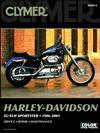
Softcover – 640 pages – Harley Davidson XL XLH Sportster 1986 – 2003 Clymer Owners Service Repair Manual covers the following Sportster XL and XLH models: XLH883 (1986 – 2003) XLH883 Custom (1999 – 2003) XLH883 Deluxe (1986 – 1995) XLH883 Hugger (1987 – 2003) XL883R (2002 – 2003) XLH1100 (1986 – 1987) XLH1200 (1988 – 2003) XL1200 Custom (1996 – 2003) XL1200 Sport (1996 – 2003)Contents: QUICK REFERENCE DATA GENERAL INFORMATIONManual organization / Warnings cautions and notes / Safety / Serial numbers / Fasteners / Shop supplies / Tools / Measuring tools / Electrical system fundamentals / Service methods / Storage / Specifications TROUBLESHOOTINGStarting the engine / Engine performance / Electrical component replacement / Starting system / Charging system / Ignition system (1986-1997 models) / Ignition system (1998-2003 models except 1200S models) / Ignition system (1998-2003 1200S models) / Fuel system / Engine noises / Engine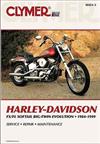
Softcover – 640 pages – Harley-Davidson FLS/FXS Softail Big Twin Evolution 1984 – 1999 Clymer Owners Service Repair Manual Covers the following Models: Harley-Davidson FLST Heritage Softail Harley-Davidson FLSTC Heritage Classic Softail Harley-Davidson FLSTF Fat Boy Harley-Davidson FLSTN Heritage Special Nostalgia Softail Harley-Davidson FLSTS Heritage Springer Softail Harley-Davidson FXST Softail Harley-Davidson FXSTB Night Train Harley-Davidson FXSTC Softail Harley-Davidson FXSTF Springer Softail Harley-Davidson FXSTS Springer Softail Harley-Davidson FXSTSB Softail Bad BoyContents: QUICK REFERENCE DATA GENERAL INFORMATIONManual organization / Notes cautions and warnings / Safety first / Service hints / Serial numbers / Parts replacement / Torque specifications / Fasteners / RTV gas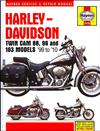
Softcover – 256 pages – Harley-Davidson Twin Cam 88 96 103 1999 – 2010 Haynes Owners Service Repair Manual Covers the following Models: Harley Softail all models 88 cid (1450cc) 2000 – 2006 Harley Softail all models 96 cid (1548cc) 2007 – 2010 Harley Dyna Glide all models 88 cid (1450cc) 1999 – 2006 Harley Dyna Glide all models 96 cid (1548cc) 2007 – 2010 Harley Touring all models 88 cid (1450cc) 1999 – 2006 Harley Touring all models 96 cid (1548cc) 2007 – 2010 Harley Touring all models 103 cid (1688cc) 2010Note: manual includes all Electra Glide Road King and Road Glide models.Contents: Maintenance Maintenance Sschedule and Procedures Engine Oil Level Check Brake Fluid Level Checks Tyre Checks Component Locations Repairs and Overhaul Engine Transmission and Associated Systems Clutch Primary Drive Fuel System and Lubrication Ignition System Frame and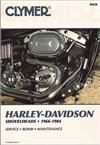
Softcover – 426 pages – Harley Davidson Shovelheads 1966 – 1984 Clymer Owners Service Repair Manual Covers the following Models: Harley-Davidson FL 1973-1984 Harley-Davidson FXE 1974-1984 Harley-Davidson FLH 1973-1984 Harley-Davidson FXEF 1980-1984 Harley-Davidson FXB 1980-1984 Harley-Davidson Super Glide (FL) 1971 Harley-Davidson FLHS 1980-1983 Harley-Davidson FXS 1978-1984 Harley-Davidson FXSB 1980-1984 Harley-Davidson FX 1973-1979 Harley-Davidson FXWG 1980-1984 Harley-Davidson Electra Glide (FL) 1966-1972Contents: QUICK REFERENCE DATA GENERAL INFORMATION TROUBLESHOOTINGEmergency troubleshooting / Engine starting / Engine noises / Engine lubrication / Clutch / Electrical problems / Breaker point ignition troubleshooting / Breakerless ignition troubleshooting / Excessive vibration / Carburetor troubleshooting / Specifications PERIODIC LUBRICATION MAINTENANCE AND TUNE-UPMaintenance schedule intervals / Periodic lubrication / Period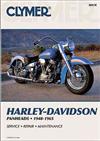
Softcover – 528 pages – Harley-Davidson Panheads 1948 – 1965 Clymer Owners Service Repair Manual Covers the following Models: Panhead E Panhead EL Panhead ELF Panhead ELS Panhead ES Panhead F Panhead FL Panhead FLE Panhead FLEF Panhead FLF Panhead FLH Panhead FLHF Panhead FLS Panhead FLSP Panhead FSContents: QUICK REFERENCE DATA GENERAL INFORMATIONManual organization / Saervice hints / Safety first / Expendable supplies / Shop tools / Emergency tool kits / Troubleshooting and tune-up equipment / Specifications TROUBLESHOOTINGEngine / Starting difficulties / Poor performance / Clutch and transmission / Drive train / Chassis / Brakes / Electrical system / Charging system / Lighting / Fuses / Wiring LUBRICATION MAINTENANCE AND TUNE-UPRoutine safety checks / Maintenance intervals / Cleaning your Harley / Tyres and wheels / Periodic lubrication / Periodic maintenance / Non-scheduled maintenance / Tune-up / Breaker point ignition service / Carburetor adjustment / Storage ENGINEPanhead engine overview / Service precautions / Special tools / Servicing engine in fra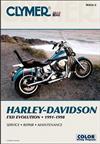
Softcover – 534 pages – Harley-Davidson FXD Evolution 1991 – 1998 Service Repair Manual Covers the following Models: FXDB Dyna Glide (1991-1992) FXDC Dyna Custom (1992) FXDL Dyna Low Rider (1993-1998) FXDWG Wide Glide (1993-1998) FXD Dyna Super Glide (1995-1998) FXDS-CONV Dyna Low Rider Convertible (1995-1998)Contents: QUICK REFERENCE DATA GENERAL INFORMATIONManual organization / Notes cautions and warnings / Safety first / Service hints / Serial Numbers / Parts replacement / Torque specifications / Fasteners / Lubricants / Sealants cements and cleaners / Expendable supplies / Basic hand tools / Test equipment / Measuring tools / Special tools / Mechanic TROUBLESHOOTINGOperating requirements / Troubleshooting instruments / Testing electrical equipment / Engine performance / Electric starting system / Charging system / Ignition system / Fuel system / Engine noises / Engine lubrication / Clutch / Transmission / Electrical pro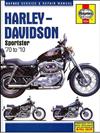
Hardcover – 228 pages – Harley Davidson Sportsters 1970 – 2010 Haynes Owners Service Repair Manual Covers the following Models: XL XLH XLCH 883 Hugger Sportster Deluxe Custom Low Roadster 1970 – 1971 1986 – 2010 XL XLX-61 XLH XLCH XLS 1000 Sportster Roadster Anniversary 1972 – 1985 XL XLH 1100 Sportster. 1986 – 1987 XL XLH 1200 1200C 1200S 1200N 1200L 1200R Sportster 1998 – 2010DOES NOT include XR-1000 engine information or 2009-on XR models.Contents Living With Your Harley Davidson- Introduction- Milwaukee Magic- Ackowledgements- About this Manual- Identification Numbers- Buying Spare Parts- Decoding the Vehicle Identification Number (VIN)- Safety First! Daily (Pre-Ride) Checks- Engine Oil Level Check- Suspension Steering and Final Drive Checks- Legal and Safety Checks- Tyre Checks Maintenance- Routine Maintenance and Servicing- Specifications- Recommended Lubricants and Fluids- Component Locations- Maintenance Schedule- Maintenance Procedures Repairs and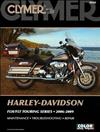
Softcover – 744 pages – Harley-Davidson FLH FLT Touring Series 2006 – 2009 (Includes CD Rom) Clymer Owners Service Repair Manual covers the following models: FLHT Electra Glide Standard (2006-2009) FLHTI Electra Glide Standard (2006) FLHTC Electra Glide Classic (2007-2009) FLHTCI Electra Glide Standard (2006) FLHTCU Ultra Classic Electra Glide (2007-2009) FLHTCUI Ultra Classic Electra Glide (2006) FLHTCUSE Screamin Eagle Ultra Classic Electra Glide (2006) FLHTCUSE2 Screamin Eagle Ultra Classic Electra Glide (2007) FLHTCUSE3 Screamin Eagle Ultra Classic Electra Glide (2008) FLHTCUSE4 Screamin Eagle Ultra Classic Electra Glide (2009) FLHR Road King (2006-2009) FLHRI Road King (2006) FLHRS Road King Custom (2006-2007) FLHRSI Road King Custom (2006) FLHRC Road King Classic (2007-2009) FLHRCI Road King Classic (2006) FLHRSE3 Screamin Eagle Road King (2007) FLHRSE4 Screamin Eagle Road King (2008) FLHX Street Glide (2006-2009) FLHXI Street Glide (2006) FLTR Road Glide (200-2009) FLTRI Road Glide (2006) FLTRSE3 Screamin Eagle Road Glide (2009)Contents: QUICK REFEREN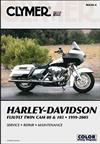
Softcover – 702 pages – Harley-Davidson FLH/FLT Twin Cam 88 103 1999 – 2005 Clymer Owners Service Repair Manual Covers the following Models: FLHT/FLHTI Electra Glide Standard (1999-2005) FLHTC/FLHTCI Electra Glide Classic (1999-2005) FLHTCUI Electra Glide Ultra Classic (1999-2005) FLHTCSE2 Screamin Eagle Electra Glide 2 (2005) FLHR/FLHRI Road King (1999-2005) FLHRCI Road King Classic (1999-2005) FLHRS/FLHRSI Road King Custom (2004-2005) FLTR/FLTRI Road Glide (1999-2005)Note: the quot;I quot; designation indicates fuel injected modelsContents: QUICK REFERENCE DATA GENERAL INFORMATIONManual organization / Warnings cautions and notes / Safety / Serial numbers / Fasteners / Shop supplies / Basic tools / Special tools / Precision measuring tools / Electrical system fundamentals / Basic service methods / Storage / Speci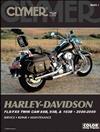
Softcover – 554 pages – Harley-Davidson FLS/FXS Twin Cam 88B 95B and 103B 2000 – 2005 Service Repair Manual Covers the following Models: Harley FLSTC/FLSTCI Heritage Softail Classic 2000-2005 Harley FLSTF/FLSTFI Fat Boy 2000-2005 Harley FLSTFI Fat Boy 15th Anniversary Edition 2005 Harley FLSTFSE Screamin Eagle Fat Boy 2005 Harley FLSTS/FLSTSI Heritage Springer 2000-2004 Harley FLSTN/FLSTNI Softail Deluxe 2005 Harley FLSTSC/FLSTSCI Softail Springer Classic 2005 Harley FXST/FXSTI Softail Standard 2000-2005 Harley FXSTB/FXSTBI Night Train 2000-2005 Harley FXSTS/FXSTSI Springer Softail 2000-2005 Harley FXSTD/FXSTDI Softail Deuce 2000-2005 Harley FXSTDSE2 Screamin Eagle Deuce 2004Contents: QUICK REFERENCE DATA GENERAL INFORMATIONManual organization / Warnings cautions and notes / Safety / Serial numbers / Fasteners / Shop supplies / Basic tools / Special tools / Precision measuring tools / Electrical system fundamentals / Basic service methods / Storage / Specifications TROUBLESHOOTINGEngine principles / Operating requirements / Starting the engine / Engine performance / Starting system / Charging system / Ignition system (carbureted mo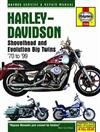
Hardcover – 270 pages – Harley-Davidson Shovelhead and Evolution Big Twins 1970 – 1999 Haynes Owners Service Repair Manual Covers the following Models: FL FLH FLHS 1200cc 1970 – 1980 FX FXE FXS FXEF 1200cc 1970 – 1980 FLT FLTC/U FLH FLHF FLHR FLHS FLHT FLHTC/U 1340cc 1978 – 1999 FXR FXRS FXRS-SP FXRS-CONV FXLR FXRD FXRT 1340cc 1982 – 1999 FXB FXD FXE FXDG FXDL FXDWG FXDS-CONV FXEF FXS FXSB FXWG FXST FXSTC FXSTS FLST FLST-SP FLSTC FLSTF FLSTN 1340cc 1979 – 1999 FXD FXDB FXDC FXDL FXDS-CONV FXDWG 1340cc 1991 – 1998Please note: This manual DOES NOT include police models.Contents: Living With Your HARLEY-DAVIDSON BIG TWINIntroduction: Miwaukee magic; Ackowledgements; About this manual; Identification numbers: buying spare parts; decoding the Vehile Identification Number (VIN); Safety first! Daily (Pre-Ride) Checks: Engine oil level check; Suspension steering and final-drive checks; Tyre checks. MaintenanceRoutine Maintenance and Servicing: Specifications; Recommended lubricants and fluids; Component locations; Maintenance schedule; Maintena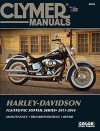
Harley Davidson Softail FLS FXS FXC Models 2011 – 2016 Clymer Owners Service Repair Manual covers the following models: FLS 103 Softail Slim (2012 – 2016) FLSS 110 Softail Slim (2016) FLSTC Heritage Softail Classic (2011) FLSTC 103 Heritage Softail Classic (2012 – 2016) FLSTC ANV Heritage Softail Classic 110th Anniversary Edition (2013) FLSTF Fat Boy (2011) FLSTF Fat Boy 103 (2012 – 2016) FLSTF Fat Boy Lo 103 (2012 – 2016) FLSTFB Fat Boy Lo (2011) FLSTFB ANV Fat Boy Lo 110th Anniversary Edition (2013) FLSTFB 103 Fat Boy Lo (2012 – 2016) FLSTFB 103 ANV Fat Boy Lo 110th Anniversary Edition (2013) FLSTFBS 110 Fat Boy Lo (2016) FLSTN Softail Deluxe (2011) FLSTN 103 Softail Deluxe (2012 – 2016) FLSTNSE CVO Softail Deluxe (2014) FLSTSB Softail Cross Bones (2011) FTSTSE2 CVO Softail Convertible (2011) FTSTSE3 CVO Softail Convertible (2012) FXCWC Rocker C (2011) FXS 103 Blackline (2012-2013) FXSB 103 Softail Breakout (2014 – 2016) FXSBSE 110 Softail Breakout (2013 – 2015) FXST 103 Softail Standard (2011 – 2013)Contents: QUICK REFERENCE DATA GENERAL INFORMATION Manual organization / Warnings cautions and notes / Safety / Serial numbers / Fasteners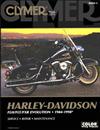
Softcover – 924 pages – Harley Davidson FLH FLT FXR Evolution 1984 – 1998 Clymer Owners Service Repair Manual Covers the following Models: FLHR Road King (1995-1998) FLHR-I Road King (1996-1997) FLHRC-I Road King (1998) FLHS Electra Glide Sport (1988-1993) FLHT Electra Glide (1995-1998) FLHTC Electra Glide Classic Anniversary (1984-1998) FLHTC-I Electra Glide Classic (1996-1998) FLHTC-U Electra Glide Classic-Ultra Anniversary (1989-1997) FLHTC-UI Electra Glide Classic-Ultra Anniversary (1996-1998) FLTC Tour Glide (1984-1991) FLTC-U Tour Glide-Ultra Classic (1989-1995) FLTC-UI Tour Glide-Ultra Classic (1996) FLTR Road Glide (1998) FLTR-I Road Glide (1998) FXEF Fat Bob (1985) FXLR Low Rider Custom Annivers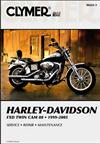
Softcover – 590 pages – Harley Davidson FXD Twin Cam 88 1999-2005 Clymer Owners Service Repair Manual Covers the following Models: FXD/FXDI Dyna Super Glide (1995-2005) FXDS-CONV Dyna Super Glide Convertible (1999-2000) FXDL/FXDLI Dyna Low Rider (1999-2005) FXDWG/FXDWGI Dyna Wide Glide (1999-2005) FXDX/FXDXI Dyna Super Glide Sport (1999-2005) FXDC/FXDCI Dyna Super Glide Custom (2005) FXDP Dyna Defender Police (2001-2004)Table of Contents: QUICK REFERENCE DATA GENERAL INFORMATIONManual organization / Warnings cautions and notes / Safety / Serial numbers / Fasteners / Shop supplies / Basic tools / Precision measuring tools / Electrical system fundamentals / Special tools / Basic service methods / Storage / Specifications TROUBLESHOOTINGOperating requirements / Starting the engine / Engine performance / Electric starting system / Charging system / Ignition system / Fuel sy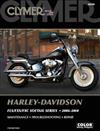
Softcover – 674 pages – Harley Davidson Softail FLS FXS FXC Models (Plus CD) 2006 – 2010 Clymer Owners Service Repair Manual covers the following models: FLST/FLSTI Heritage Softail (2006) FLSTC / FLSTCI Heritage Softail Classic (2006 – 2010) FLSTC / FLSTCI Shrine (2006 – 2010) FLSTF / FLSTFI Fat Boy (2006 – 2010) FLSTC FLSTF /FLSTFI Shrine (2006 – 2010) FLSTFB Softail Fat Boy Lo (2010) FLSTFSE2 Screamin Eagle Fat Boy (2006) FLSTN / FLSTNI Softail Deluxe (2006 – 2010) FLSTSB Softail Cross Bones (2008 – 2010) FLSTSC / FLSTSCI Softail Springer Classic (2006 – 2007) FLSTSE Softail CVO Convertible (2010) FXCW Softail Rocker (2008 – 2009) FXCWC Softail Rocker Custom (2008 – 2010) FXST / FXSTI Softail Standard (2006 – 2009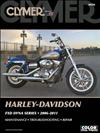
Softcover – 530 pages – Harley Davidson FXD Dyna Series 2006 – 2011 Clymer Owners Service Repair Manual covers the following models: Harley FXD Dyna Super Glide 2006-2010 Harley FXDC Dyna Super Glide Custom 2006-2011 Harley FXDL Dyna Low Rider 2006-2009 2010-2011 HDI Japan only Harley FXDWG Dyna Wide Glide 2006-2008 2010-2011 Harley FXD35 35th Anniversary Super Glide 2006 Harley FXDB Street Bob 2006-2011 Harley FXDF Fat Bob 2008-2011 Harley FXDSE Screamin Eagle Dyna 2007 Harley FXDSE2 Screamin Eagle Dyna 2008 Harley FXDFSE CVO Dyna Fat Bob 2009 Harley FXDFSE2 CVO Dyna Fat Bob 2010Contents: QUICK REFERENCE DATA GENERAL INFORMATIONManual organization / Warnings cautions and notes / Safety / Serial numbers / Fasteners / Shop supplies / Tools / Measuring tools / Decimal place values / Electrical system fundamentals / Service methods / Storage / Specifications TROUBLESHOOTINGOperating requirements / Engine starting / Engine performance / Engine noises / Electrical testing / Starting system / Charging system / Ignition system / Fuel system / Engine lu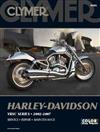
Softcover – 660 pages – Harley-Davidson VRSC Series 2002 – 2007 Clymer Owners Service Repair Manual covers the following models: Harley-Davidson VRSCA V-Rod 2002-2006 Harley-Davidson VRSCB V-Rod 2004-2005 Harley-Davidson VRSCAW V-Rod 2007 Harley-Davidson VRSCSE Screamin #39; Eagle 2005-2006 Harley-Davidson VRSCX Screamin #39; Eagle 2007 Harley-Davidson VRSCR Street Rod 2006-2007 Harley-Davidson VRSCD Night Rod 2006-2007 Harley-Davidson VRSCDX Night Rod Special 2007Contents: QUICK REFERENCE DATA GENERAL INFORMATION TROUBLESHOOTING LUBRICATION MAINTENANCE AND TUNE-UPMaintenance intervals / Engine oil / Control lever lubrication / Drive belt deflection and adjustment / Engine mounts and stabilizer / Tune-up / Engine rotation / Air filter / Compression test / Ignition timing / Valve clearance / Secondary camshaft chain tensioner / Spark plugs ENGINE TOP END AND EXHAUST SYSTEMCylinder head covers / C
Keywords: Harley-Davidson Sportster XL883, XL1200 2004 – 2013Clymer Owners Service and Repair Manual
Keywords: Harley-Davidson Sportsters 1959 – 1985 Clymer Owners Service and Repair Manual
Keywords: Harley Davidson XL XLH Sportster 1986-2003 Clymer Owners Service and Repair Manual
Keywords: Harley-Davidson FLS/FXS Softail Big Twin Evolution 1984 – 1999Clymer Owners Service and Repair …
Keywords: Harley-Davidson Twin Cam 88, 96 and 103 1999 – 2010Haynes Owners Service and Repair Manual
Keywords: Harley Davidson Shovelheads 1966 – 1984 Clymer Owners Service and Repair Manual
Keywords: Harley-Davidson Panheads 1948 – 1965 Clymer Owners Service and Repair Manual
Keywords: Harley-Davidson FXD Evolution 1991 – 1998 Clymer Owners Service and Repair Manual
Keywords: Harley Davidson Sportsters 1970 – 2010 Haynes Owners Service and Repair Manual
Keywords: Harley-Davidson FLH and FLT Touring Series 2006 – 2009 (Includes CD Rom)Clymer Owners Service …
Keywords: Harley-Davidson FLH, FLT Twin Cam 88 and 103 1999 – 2005Clymer Owners Service and Repair Manual
Keywords: Harley-Davidson FLS/FXS Twin Cam 88B, 95B and 103B 2000 – 2005Clymer Owners Service and Repair …
Keywords: Harley-Davidson Shovelhead and Evolution Big Twins 1970 – 1999Haynes Owners Service and Repair …
Keywords: Harley-Davidson FLS, FXS, FXC Softail 2011-2016 Clymer Owners Service and Repair Manual
Keywords: Harley-Davidson FLH, FLT, FXR Evolution 1984 – 1998Clymer Owners Service and Repair Manual
Keywords: Harley Davidson FXD Twin Cam 88 1999-2005 Clymer Owners Service and Repair Manual
Keywords: Harley-Davidson FLS, FXS, FXC Softail Series 2006 – 2010 (Plus CD)Clymer Owners Service and …
Keywords: Harley Davidson FXD Dyna Series 2006-2011 (CD with Flowcharts and Wiring Diagrams)Clymer Owners …
Keywords: Harley-Davidson VRSC Series 2002 – 2007 Clymer Owners Service and Repair Manual
The Topper had a 165 cc (10.1 cu in) single-cylinder two-stroke engine mounted horizontally between the floorboards. The system needed a premixed gasoline/oil blend. The starter was associated with rope-recoil means just like garden mowers or the Lambretta E model. Unlike more scooters with encased machines, the Topper’s system did not have a cooling fan. It absolutely was anticipated that the low, horizontally attached system would-be cooled by air moving underneath the scooter, however some Toppers created overheating problems. The system utilized a reed device with its induction system.
The motor driven a continually variable transmission labeled as “Scootaway Drive” that included a protection device that couldn’t enable the scooter to maneuver from sleep at system speeds more than 1800 rpm. Last drive ended up being by an exposed roller chain.
The Topper have 5 inches interior broadening drum brakes on both wheels. Leading brake had been managed by a give lever on the left handlebar with a parking braking system lock; a corner brake had been controlled by a pedal.
Leading body, forward fender and floorboards associated with Topper had been manufactured from stamped metal, and the engine cover and the body are made from molded fiberglass. Space for storing ended up being supplied beneath the chair; the maker recommended storing additional containers of two-stroke oil there.
Development
The primary problem from Topper proprietors was using the “Scootaway Drive” continually adjustable transmission. Roadway grime would go into the transmission and cause the gear to slide. A transmission, using the major drive sealed in an oil bath, was launched for 1961.
The Topper H had been launched in 1961 (sold through 1965) with a new alloy cylinder head that increasing the compression ratio to 8.0:1, a reusable foam air filter, and revisions into the cylinder harbors and air intake tube.
A detuned type of the Topper has also been available, aided by the energy limited to 5 hp (3.7 kW). This is marketed once the “Topper U”. The detuned Topper was built to adhere to legislation in certain shows in the United States that let motorbikes with rated motor power below a reported optimum to be operated without a license or even to become operated on an unique permit by cyclists at a younger years than is let an everyday motorcycle license.
Overall Performance
In 1959, a Topper had been ridden from Bakersfield, California to Death Valley and straight back without restoration or modifications calling for hardware. The route experienced Trona, through Mojave Desert to Stovepipe Wells, to Badwater Basin, the cheapest part of North America at 282 ft (86 m) below sea-level, then to Whitney Portal, 7,851 feet (2,393 m) above sea level on the side of Mount Whitney, after which they gone back to Bakersfield.
The Harley-Davidson Baja 100 was a tiny displacement off road bike designed for Harley-Davidson in Italy by Aermacchi, that was 50percent possessed by Harley-Davidson at that time. It absolutely was among Harley-Davidson’s attempts to go into the tiny displacement off road bike market. It absolutely was built-in Aermacch’s Varese, Italy factory.
They have a 98 cc (6.0 cu in) two-stroke, single cylinder system with five rate transmission, produced from current two-stroke production, mostly Aletta and Aletta d’Oro off the shelf components by reducing bore from 54 mm to 50 mm.
The only real purpose-made parts had been the framework to allow for when it comes to front owner when it comes to cylinder mind together with air conditioner filter container.
Manufacturing runs
The first production run started in September 1969 and finished just before August, usually the time of the season when factories were closed for holiday breaks and therefore a design year introduced.
Manufacturing
1969: 853 the ’70 MSR
1970: 569 MSR MY ’70 MSR
1970: 1204 MSR MY ’71
1971: 704 MY ’72 SR and 200 MY ’72 MSR
1972: 1008 our 73 MSR
Manufacturing works of 1973 aren’t understood even though some MY 74 models seem to occur but which means that there has been no adjustment after MY73.
Usually framework data (which are repeated regarding the system) begin with 8B regarding MSR (competitors design) and 8C the “street design” which had lighting, muffler and a top front fender. But for some early “street products” the MSR framework numbering may apply.
A significant renovation were held end of 1972 as soon as the engine was fitted with a brand new aluminum cylinder and carburetor, and equipment move regarding the right-side of this system. There have been various other small variations including the back hand or even the lost vent in the container.
The Baja had a racing record and won the Baja 1000 in 1971 utilizing the formal Harley-Davidson employees in its class. For the reason that competition Harley joined some 14 Baja systems, which 8 done in top 10, like the competition winner.
In a F-head/IOE motor, the intake manifold and its particular valves are observed atop the cylinders, in the cylinder head, consequently they are run by rocker hands which reverse the movement of this pushrods so the consumption valves available downward into the burning chamber. The fatigue manifold as well as its valves can be found beside or within the cylinders, in the block. The fatigue valves are generally roughly or exactly parallel because of the pistons; their particular faces aim upwards and they are not managed by individual pushrods, but by contact with a camshaft through tappet or valve lifter and an integrated valve stem/pushrod. The valves had been counterbalance to one part, forming exactly what seemed to be a pocket, leading to the definition of “pocket valve” getting used for IOE motors. An F-head system combines properties from both overhead-valve and flathead means motors, the inlet device running via pushrod and rocker arm and opening downward like an overhead device motor, as the fatigue device try counterbalance from cylinder and starts up via an integrated pushrod/valve stem straight actuated by the camshaft, much like the valves in a flathead motor.
Origin
The initial IOE layouts made use of atmospheric inlet valves that have been held shut with a poor springtime and are exposed by the pressure differential produced if the piston took place on inlet stroke. This worked really with low-speed early machines together with the main benefit of being very simple and low priced, however the weak spring was struggling to close the valve quickly adequate because the RPM’s of motors increased, necessitating stronger springs, which in turn recommended direct technical action to open, since the atmospheric force of 15psi limits the total power offered by promoting a pressure differential, and therefore a 15-lb springtime is the strongest which can be used (for useful needs, it might have to be less heavy however). As soon as the limitations of the system were achieved, the design ended up being enhanced without significant adjustment into head casting by adding a mechanical system to start the inlet valves and more powerful springs to shut all of them. In both matters, the exhaust valves had been into the block and were opened by experience of a camshaft through a tappet or device lifter and closed by springs.
Benefits
The IOE build permits the utilization of bigger valves than a sidevalve (or L-head) or overhead-valve system. Their importance on the sidevalve/flathead include a tight combustion chamber, a well-located spark plug, and a cooling result through the blend swirl, along with much better intake combination flow.. Disadvantages consist of a burning chamber of more complicated shape than compared to an overhead valve motor, which effects combustion prices and may write hot spots in piston mind, and lower device place, which hinders efficient scavenging. Because of the included problems of rocker hands and pushrods, it is also more complex and pricey to create than a sidevalve engine, also becoming physically bigger due to the rocker hands being put on the cylinder mind, and it needs an inlet valve and ports into the cylinder head, while the cylinder of a sidevalve motor is just a closed-end cylinder.
Rover IOE engines
Closeup of two cylinders in a 3-litre Rover IOE motor. You can view the combustion chamber, angled piston top, and exhaust device.
Rover utilized an even more advanced as a type of IOE motor. It had been created by Jack Swain in the mid-late 1940s and was in manufacturing from 1948 towards very early 1990s. Unlike the conventional F-head IOE, this had a simple yet effective burning chamber designed for close burning, in place of quick manufacture. The very best surface of this block is machined at an angle, using piston crowns angled in a “pitched roof” to suit. At TDC, the piston virtually touched the angled inlet valve and offered close ‘squish’ on combustion chamber itself, counterbalance aside by one half a cylinder diameter. The resultant combustion chamber shape is a near-ideal hemisphere, although inverted and tilted from typical “hemi-head” design. The spark plug was centrally mounted which, with the turbulence generated by the squish, offered a quick flame road. The thinness of the fuel level between piston and inlet device ended up being therefore restricted regarding reduce steadily the risk of detonation on poor gas, one component that kept they in service with Land Rover for so long. Throughout the late 1940s and early 1950s whenever only petrol readily available ended up being lower octane ‘pool’ petrol it let Rover to perform higher compression ratios than many competitors using even more usual side- or overhead-valve design.
The uncommon burning chamber arrangement with its angled valves additionally resulted in an unusual device train. The block-mounted camshaft runs little wedge-shaped rockers, one for every single valve. At the beginning of versions the camshaft acts on a straightforward pad in the rocker, but for later designs this pad ended up being replaced by a roller follower. The fatigue rockers perform entirely on the valves, while the inlet rockers perform on pushrods running up to another group of longer flat rockers running the inlet valves. The Rover motor, like most 1940s and earlier in the day British styles, is a tiny bore, long-stroke (undersquare) system to keep the RAC income tax horse power rating only feasible, hence keeping the trail taxation as low as possible. The IOE design allowed Rover to use bigger valves than would typically become feasible in a little bore engine, permitting best breathing and better performance.
The Rover IOE motor families encompassed straight-4 (1.6- and 2.0-litres) and straight-6 (2.1-, 2.2-, 2.3-, 2.4-, 2.6- and 3.0-litres) engines and operated a lot of their post-war range in the form of the P3, P4 and P5 systems. Adjusted models regarding the 1.6 and 2.0 IOE engines were used during the early form of the Land Rover aswell. Energy outputs ranged from 50bhp (Land Rover 1.6) to 134bhp (P5 3 litre MkII & III). The 2.6 6-cylinder IOE system had a really long job. After getting used in Rover P4 saloon cars it had been included with long-wheelbase Land Rover versions from 1963 in 2A ahead controls models, after that in 1967 in the bonneted 109″, and remained an optional fitment until 1980 with regards to ended up being replaced because of the Rover V8.
Close Packard cylinder head
The design of combustion chamber as an “inverted hemi-head”, combined with angled cylinder head joint and pitched-roof piston crowns, had earlier on been used in the 1930 Van Ranst-designed Packard V12 engine, although in cases like this the valves were in both the block as part valves as well as the spark-plug is badly placed during the extremity of this combustion chamber.
Model W, singles, and 45s (DL, RL, and WL)
The flathead motor spotted solution in Harley-Davidson motorcycles beginning with the design W’s flat-twin, made out of 1919 to 1923, and continuing in 1924 with single-cylinder export-model 21-cubic-inch (340 cc) and 30.5-cubic-inch (500 cc) singles and continued in Servi-Cars until 1973. Within the domestic U.S. marketplace, the 45-cubic-inch (740 cc) DL design (1929 to 1931) and its particular technical descendant, the RL model (1932 to 1936), began Harley’s side-valve tradition in 45-cubic-inch displacement course. The DL and RL systems featured a total-loss oiling program and had been succeeded in 1937 by the WL 45, which had recirculating oil lubrication. The WL proceeded to offer in World War II because the U.S. and Canadian Army’s biggest two-wheeled mount and later as a civilian middleweight through 1952. The motor proceeded virtually unchanged with different G-based designations within the three-wheeled “Servi-Car” until manufacturing stopped in 1973.
K-series and advancements
In 1952, the K series flatheads was introduced, attempting to sell in parallel using W series (which was stopped after 1952), built to take on Uk sporting motorbikes of that time period, whilst the United states motorcycle relationship permitted the 750 cc sidevalves to compete against 500 cc overhead-valve bicycles. The K models showcased a unit building engine and transmission circumstances, right side foot move and left part base braking system, and evolved from 45 cubic inches (1952 to 1953) to 55 cubic inches by a 0.75-inch (19 mm) escalation in stroke size (1954 to 1956) over its five-year retail marketplace run. The K-series ended up being replaced by the overhead-valve Sportster sets when you look at the retail market in 1957. However, rushing versions for the 750 cc K design, designated KR, stayed produced in not a lot of numbers for some time shortly after, winning both roadraces and dust keep track of occasions against overhead valve bikes limited to 500 cc through 1969, when the American bike relationship eventually decided to replace the guidelines making the venerable flatheads uncompetitive. The K racers are changed first by the iron-head XR 750 cc overhead valve system, and two ages later because of the alloy-head XR, which continues in service in level track race to this day.
Flathead huge twins
In 1930, the 74-cubic-inch (1,210 cc) VL flathead replaced the JD Big Twin, which have showcased intake-over-exhaust (IoE) device setup. The VL had a single downtube frame and complete control oiling, culminating in an 80-cubic-inch (1,300 cc) version (VLH) in 1935. In 1937, that motor had been redesigned to incorporate a recirculating lubrication system, and designated the design U, also it moved to the same framework and working equipment configuration as the model age Knucklehead, which have originated in 1936. The U continued to be produced in different designs as a 74 cubic inch U & UL (1937 to 1948), and 80 cubic inches UH & ULH motor (1937 to 1941). By the period, the initial seasons of aluminum-head Panhead, it turned out thoroughly superseded and outsold available because of the superior overall performance associated with overhead valve model Big Twins.
The knucklehead try a retronym utilized by fans to mention to a Harley-Davidson bike motor, so-named because of the distinct form of the rocker bins. The motor try a-two cylinder, 45 degree, pushrod actuated overhead-valve V-twin system with two valves per cylinder. It absolutely was the 3rd standard particular V-Twin system employed by Harley-Davidson, changing the Flathead-engined VL design in 1936 as HD’s top-of-the-line model. The motor is manufactured until 1947 and was changed because of the Panhead engine in 1948. The Knucklehead-engined designs had been initially known as “OHVs” by fans of that time period plus Harley’s official literary works; the nickname arose through the California chopper tradition for the belated 1960s.
Due to the fact design of Harley-Davidson motors possess evolved over time, the distinctive model of the device protects possess permitted Harley fans to categorize a motor simply by studying the shape of the cover. The knucklehead system valve protects have contours resembling knuckles on someone’s fist that give the knucklehead its title.
The panhead was a Harley-Davidson motorcycle motor, so nicknamed due to the distinct model of the rocker covers. The motor was a two-cylinder, two-valve-per-cylinder, pushrod V-twin. The system changed the Knucklehead motor in 1948 and is produced until 1965 with regards to was changed by the Shovelhead.
While the build of Harley-Davidson engines evolved through the years, the distinctive shape of the valve protects has let Harley fans to classify a motor by just taking a look at the model of the covers, and also the panhead possess protects resembling an upside-down cooking pan.
The “Captain The united states” chopper utilized by Peter Fonda into the film effortless driver (1969) had a panhead engine, as did the “Billy bicycle” ridden by Dennis Hopper’s personality.
At this time, some 3rd party motor manufacturers produce personalized panhead-style engines in many different bores, many much larger compared to the original-design displacements. Each producer includes considerable simple upgrades into initial build to considerably improve the overall performance and dependability while nevertheless providing the earliest styling and general motor construction.
The Shovelhead are an air-cooled, 45 level, V-twin motorcycle motor made of 1966 to 1985 by Harley-Davidson. Preliminary versions have an engine displacement of 1,208 cc (74 cu in). Around halfway through production of the 1978 model seasons, this was risen to 1,340 cc (82 cu in) for many of Harley’s larger Twin bicycles. 1340cc, referred to because of the business as 80ci., engines are recommended on FLH designs halfway through 1978 and through most of ’79 before getting standard equipment for FLH designs in 1980. These bicycles are called FLH-80 Electra Glide II products. FX model bikes stayed provided with either 1200 or 1340 cc motors till 1981 whenever 1340cc, generally known as 80 ci., is made standard across the Big Twin range.
Customized Shovelhead Electra Glide
The “shovel” cylinder mind represented an offshoot of the Harley-Davidson_Knucklehead system but featured a slightly different search. Title is based on the look of the rocker field protects. Since these protects think of the top of coal shovels whenever inverted, the name shovelhead was an all-natural development. The shovel engines powered Harleys up until the development of the development engine in 1984, ending the reign associated with “shovel” as enthusiasts usually call these motors. The shovel engine doesn’t have protects, per se, but rocker containers and rocker hands which pivot on shafts. The design offered above a unique search; they created 10per cent most horse power compared to the panhead motor which they replaced. From 1966 through 1969 the shovelhead held the panhead style entry level. These very early style shovelheads because of the generator bottoms are also known as slabside shovels. From 1970 in the shovelheads used an alternator bottom usually called a cone shovel.
Numerous third-party engine providers build custom Shovelhead-style machines, in a variety of bores, most much larger than the initial design displacements. Each producer includes upgrades towards original build to boost the overall performance and dependability while still supplying the original styling and total system framework.
Development regarding the Sportster
Preceding, a color-coded approximate drawing associated with Sportster development device train superimposed more than a graphic of a Sportster Evolution. Crank output try purple; cams is purple; pushrod/lifters become yellow; rockers is blue; valves is dark green, with seats revealed in light-green.
The unit building of the Harley-Davidson Sportster, which was component and parcel using very successful model range since their beginning due to the fact sidevalve 750cc “K” design in 1952, had been retained using development system update in 1986, causing a distinctive device train setup. Unlike nearly every other engine in manufacturing these days, the Sportster Evolution uses one cam per motor overhead valve, leading to four specific, single-lobe, gear-driven camshafts. The cam lobes become hence all operating one behind another, and pushrods are arrayed in pairs (front side and rear) parallel on cylinder axis consequently. This enables each lifter and pushrod to deflect through the cam lobes perpendicular into the lobe airplane. This setup are friendly to radical, high-output cams, making the Sportster development an all-natural choice for the once Harley-Davidson had line of Buell bike organization sportbikes from 1986 as much as belated 2009 (2010 design 12 months).
The Sportster Evolution engine features stayed mainly unchanged from 1986 to 2006, though adjustment on transmission, best drive and motor supports have actually necessitated modifications to your Sportster advancement case. Building is virtually totally the exact same between 883 cc and 1,200 cc versions; the chief difference between the two was an inferior bore regarding the 883 cc (inherited from the earlier “ironhead” mother or father), alongside slightly different heads. Conversion rates from 883 cc to 1,200 cc are relatively cheap and prevalent, and cheaper than the purchase price premium going from an 883 to 1,200 motor on an innovative new cycle. Carburetors are standard on Sportster machines until 2007, when they are changed because of the Delphi Electronic Sequential-Port Fuel injections (ESPFI) system.
Evolution on the huge bikes
The development gigantic Twin saw a fifteen-year run-in Harley-Davidson’s “big bicycles,” in the Dyna, Softail, FXR, and Touring structures, and is essentially a newer style first class and stroker flywheel set up upon the slightly customized shovelhead situation. Sixteen seasons run in the event that you include the 2000 FXR4 restricted manufacturing CVO.
The top Twin makes use of a single, four-lobe, gear-driven camshaft present just over the crankshaft axis. Although this simplifies camshaft replacement, it complicates the top Twin device train with tappet/lifters and pushrods that all deflect from the camshaft at wildly different sides. The top Twin pushrods has a distinct helical appearance considering that the vertical plane created by each cylinder’s rockers (front-to-back) is precisely perpendicular towards straight plane formed by the cam lobes (left-to-right). The necessity for one lifter and pushrod set to get to entirely off to the most outboard cam lobe offers increase towards the Big Twin’s tell-tale offset lifter assemblies, where in actuality the forward lifter system is found slightly farther on and turned to allow the valve equipment to help make the reach.
The Big Twin has-been followed closely by several different main drives and transmissions, both on manufacturing Harley-Davidson motorbikes plus custom solutions. The aftermarket choice of add-ons of these closely associated systems are broad, since it is for the system itself.
The development Big twin-motor try, for now, the very last of type of solitary cam, overhead-valve motors tracing their particular lineage returning to the ground breaking Knucklehead build penned by president costs Harley. With its 1994 to 2000 (FXR4) best setup, with rockerbox and base gasket leaks set, they turned out to be a robust, durable, and flexible power-plant for several associated with Big Twin systems. It is also the greatest aftermarket supported Harley-Davidson build, to date.
The advancement motor (popularly known as Evo) try an air-cooled, 45-degree, V-twin engine constructed from 1984 by Harley-Davidson for the company’s motorcycles. It absolutely was made in the 1,340 cc (82 cu in) displacement for Harley Davidson Big V-twins bicycles, replacing the Shovelhead motor until 2000 whenever last EVO had been placed in a production factory personalized FXR4 (FXR2 and FXR3 are 1st CVO’s). In 1999, it had been replaced because of the Harley-Davidson Twin Cam 88 in Touring and Dyna model plus in 2000 in the Softail brands. Furthermore obtainable in the Sportster model beginning in 1986, it had been made in the 1,100 cc (67 cu in) displacement until 1988 and it is nonetheless manufactured in the 883 cc (53.9 cu in) and 1,200 cc (73 cu in) displacements for the Harley-Davidson Sportster, changing the ironhead Sportster engine.
More analysts think about the development to-be the motor that conserved the reorganized Harley-Davidson company from particular bankruptcy. Harley-Davidson’s formal title the engine had been likely linked to their attempt to reform its image following the 1981 administration buyout from previous holder United states Machine and Foundry (AMF).
Though an important build advance for Harley-Davidson in a variety of ways, the Evolution is more distinct from earlier in the day Harley-Davidson engine designs by virtue of their dependability, oils rigidity, and capability to be run hard under all kinds of conditions for tens and thousands of kilometers farther than any of its predecessors. Both minds and cylinders for the development engine are made of aluminum to reduce fat in comparison to a cast metal build. Air air conditioning performance was improved as aluminum are a superior thermal conductor to cast-iron. The usage aluminum both for heads and block decreases use on head gasket seals, versus a combined cast-iron and aluminum build which may trigger pressure on the mind gasket seals as a consequence of various rate of expansion and contraction between dissimilar metals. The blocky rocker containers (thus becoming nicknamed “block head” which never ever caught on), aluminum minds and cylinders (also called “jugs”) would be the only the main advancement motor that may be considered crucial; the major Twin and Sportster incarnations associated with the Evolution are considerably various.
88B and 96B motors
an authorities concern Twin Cam 96.
The Twin Cam initially wasn’t found in the Softail model family ahead of the season 2000. This is because of the chassis design and vibration transfer on Softail frame due to the direct (hard) mounting regarding the engine. Dyna systems is “rubber installed”, damping most vibration transfer towards frame and driver. Another reasons was that motor and transmission on a Twin Cam are straight bolted (but they are however individual products) to each other, with the chassis seat post on a Softail getting into how of a Twin Cam transmission circumstances. While the business determined that a rubber-mounted Softail would affect the line’s artistic styling, Harley fixed the matter by designing an engine variant generally Twin Cam 88B. It is basically the exact same system since the earliest (now known as “Twin Cam 88A”), however with a modified engine block design that integrate twin chain-driven balance shafts. The Twin Cam 96B engine was launched simultaneously since the Twin Cam 96A design, when it comes to 2007 design year, and had been furnished on all Softail models until it was changed because of the 103 ci version.
You are able, but to install a normal Twin Cam engine to a pre-2000 Softail (or any chassis that accepts an Evolution engine), through 3rd party adapters.
Variations from forerunner (advancement system)
The motor build differed dramatically from the forerunner the “Evo” although it shared some build elements aided by the Sportster range. The 88 signifies the displacement in cubic inches of the standard motor. The bore try 95.3 mm (3.75 in) additionally the stroke is 101.6 mm (4.00 in), indicating the displacement try 88 cu in (1,449 cc). The Twin Cam 96 displaces 96.7 cu in (1,584 cc). The company revealed 103 cu in (1,690 cc) for 2012 Softail versions and 110 cu in (1,802 cc) for Screamin’ Eagle/CVO brands.
Modification Evo Twin Cam
Displacement 82 cu in (1,340 cc) 88 cu in (1,449 cc), 96 cu in (1,584 cc), 103 cu in (1,690 cc), 110 cu. in. (1,803 cc).
Oil pump exterior. Connected through a few gears. Inside twin-gerotor. Connected right to just the right side pinion shaft. This pump is more efficient, preserves a greater force and larger volume.
Webcams Single, with 4 lobes. One per cylinder, each with 2 lobes. This enables the push rods to-be much better aligned using the rocker hands.
Cam drive Gears Quiet string. This modification was reported as necessary to satisfy EPA noise needs. Numerous consumers set up after marketplace gear-driven replacements to boost time precision.
Transmission attachment Displaced from motor Transmission casing are connected straight to the motor.
Oils container generally encompasses power box underneath the seat. Here and behind the transmission set up (except Softails, that are just like noted the Evo)
Burning chamber “D” form “tub” form. Granted to get more efficient burning and has now greater compression.
Spark firing Wasted spark (both plugs fire as well). The ignition program makes use of single coil. Plugs tend to be 14 mm (0.55 in). No squandered spark. The ignition program employs dual coils. Plugs were 12 mm (0.47 in).
Air conditioning Air-cooled In Addition air-cooled. Increasing air conditioning fin places and an oils jet that sprays the base of the pistons provide further cooling capacity.
Development
Improvement the Twin Cam were only available in early 1990s, as Harley needed to deal with dilemmas impacting the earlier Evolution engine, especially architectural weaknesses in the crankcase, oils blood supply and leakages. While aftermarket businesses such as for example S&S period earlier responded with more powerful crankcase equipment for superior Evolutions, Harley gone for a significant redesign, maintaining the system fundamentally and aesthetically much like the 45-degree, air-cooled overhead-valve idea Harley has actually made use of as it launched the V-twin to its lineup.
The Twin Cam just shared 18 section having its forerunner, as the majority of the elements were special toward motor. Since the name implies, the system makes use of two chain-driven cameras, to comply with EPA noise laws. The drivetrain is strengthened through an installing scheme called the “Revised backside Interface”, allowing the transmission situation become attached right to a corner regarding the system, with all the main drive and clutch covers playing less of a structural part; this was additionally partly the explanation for Softails not initially getting a Twin Cam for the 1999 model season.
Early prototype Twin Cam motors had significant problem because of the oiling program. These issues delayed release of the motor as scheduled the 1997 model season. When the machines had been run, oil arrived any gasketed joint plus the breather. Harley needed assistance from Paul Troxler, a young professional from Southwest study Institute and finally the issue ended up being tracked to a design which drained the cam instance in to the crankcase, and put an individual scavenge pump. Because airflow through ports in the crankcase wall surface, the cam instance was not draining precisely. After much evaluation, the solution would be to seal the cam case from crankcase and use a dual scavenge system, that has been integrated in to the motor, rather than as an outboard pump as utilized on old Big Twins since the earliest Knucklehead. However, oils ended up being still not scavenging precisely through the crankcase, and this was tracked to an acoustic occurrence because of the quality regarding the scavenge inlet. Limiting the diameter associated with inlet, a counter-intuitive option, resolved that problem.
Official site of the Harley-Davidson Motor Company. View Harley-Davidson motorcycles, locate a dealer, and browse parts & apparel.
Glendale Harley-Davidson® in Glendale CA | New and Pre …
Glendale Harley-Davidson® is a Harley-Davidson® motorcycle dealer for new and used bikes, as well as parts and services in Glendale, California
Bartels’ Harley-Davidson® | Marina Del Rey, CA …
Welcome to Bartels’ Harley-Davidson® Bartels’ Harley-Davidson® is an authorized Harley-Davidson® dealership in Marina del Rey, CA. Along with a large selection of …
HOG stock quote – Harley-Davidson, Inc. stock price …
Stock quote for Harley-Davidson, Inc. (HOG) – Get real-time last sale and extended hours stock prices, company news, charts, and company-specific research tools for …
Harley-Davidson (@harleydavidson) | Twitter
Harley-Davidson @ harleydavidson. The official Twitter feed for the Harley-Davidson Motor Company. We fulfill dreams of personal freedom.
Los Angeles Harley-Davidson® of Anaheim | Anaheim, CA …
Los Angeles Harley-Davidson® of Anaheim is a Harley-Davidson® motorcycle dealer for new and used bikes, as well as parts and services in Fullerton, California and …
Pre-Owned Inventory | Los Angeles Harley-Davidson® of Anaheim
Los Angeles Harley-Davidson® of Anaheim is a Harley-Davidson® motorcycle dealer for new and used bikes, as well as parts and services in Fullerton, California and …
Harley-Davidson – Wikipedia, the free encyclopedia
Harley-Davidson, Inc. (H-D), or Harley, is an American motorcycle manufacturer, founded in Milwaukee, Wisconsin in 1903. As one of two major American motorcycle …